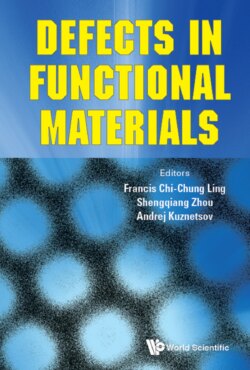Читать книгу Defects in Functional Materials - Группа авторов - Страница 27
3.2.2. Mo vacancy
ОглавлениеCompared to the mobile Mo adatom defects, Mo vacancies are less frequently observed to migrate within the monolayer lattice. Jin et al. utilized high acceleration voltage to observe the evolution of the vacancies through time-elapsed ADF-STEM imaging series [31]. Figure 7 shows one time-sequential example of the migration of Mo vacancies with initial, metastable, and final states all imaged in one series of vacancy hopping. This Mo vacancy migration is actually the movement of neighboring Mo lattice atom. In the corresponding structure models in Figs. 7(e)–7(h), the migrating Mo lattice atom neighboring the Mo vacancy is highlighted in blue and purple, with arrows indicating the distance and direction of the next hopping. Again, in the vacancy hopping, the defect migration still obeys the random walk behavior without directional preference, typical of the Brownian motion of particles. Also, the Mo vacancy hopping only occurs within the sublattice of Mo and would never enter the S sublattice. Consistent with the DFT calculation, statistical analysis confirms the ground-state VMo and metastable (Figs. 8(a) and 8(b), which suggest us a most likely kinetic pathway for vacancy migration.
As shown in Figs. 8(c) and 8(d), the DFT-calculated energetics in the VMo → →VMo pathway give an initial migration barrier of 2.9 eV, which is much higher than the simple surface migration of Mo adatom. This contrasting energy barrier is easy to understand since the migration of Mo atom in the vacancy migration case is confined within the central Mo atomic plane of the sandwiched trilayers. Fewer degrees of freedom in the confined space and the breaking and reorganization of Mo–S bonds in the vacancy migration would account for its high energy barrier, compared with the simple adatom migration. The presence of only one metastable state also reflects the decreased degree of freedom in the in-plane vacancy diffusion, since more metastable states appear in the adatom migration [31].
Figure 8. States of vacancy and their evolution. (a) and (b) Statistical counts and dwell time of vacancies and their metastable states during the migration of an Mo vacancy. (c) DFT-calculated migration pathway of Mo vacancy. The dynamic process is shown by the inset atomic models with arrows illustrating the migration pathway of the neighboring Mo atom. (d) Detailed atomic dynamics of Mo vacancy migration with top-view and side-view, respectively. Note the VMo → → VMo transition in c is symmetric: hence, only the first half process of vacancy migration (right red arrow in (c)) is drawn in detail in (d). Reproduced from Jin et al. (2017) with permission.
Such a high energy barrier of 2.9 eV also indicates that the vacancy migration must be induced by the beam–atom scattering interaction, since this order of energy barrier is not accessible by thermal activation at room temperature. Hence, the observed vacancy migration is a process driven by the electron beam which transfers enough energy to excite the target atom/defect into its metastable states.
